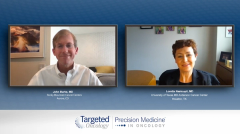
Overview of DLBCL
Loretta Nastoupil, MD, and John Burke, MD, discuss the therapeutic landscape for patients with transplant-ineligible, relapsed/refractory (R/R) diffuse large B-cell lymphoma (DLBCL) and begin with an overview of the disease.
Episodes in this series

Loretta Nastoupil, MD: Hello, and thank you for joining this Targeted Oncology™ presentation, entitled, “CD19 as a Therapeutic Target in Diffuse Large B-Cell Lymphoma [DLBCL].” Patients with relapsed/refractory [R/R] diffuse large B-cell lymphoma DLBCL who are ineligible for autologous stem cell transplant have relatively few treatment options and poor outcomes. CD19 [cluster of differentiation 19] has become a therapeutic target of increasing interest, and both CAR [chimeric antigen receptor] T-cell therapy and [use of] monoclonal antibodies directed at CD19 have shown promise in this patient population. In today's Precision Medicine and Oncology® discussion, we will talk about the role of CD19 in the therapeutic landscape for patients with transplant-ineligible, R/R DLBCL. I'm Dr Loretta Nastoupil, associate professor in the Department of Lymphoma/Myeloma at The University of Texas MD Anderson Cancer Center in Houston. Joining me today is my colleague, Dr John Burke, a hematologic oncologist at Rocky Mountain Cancer Center in Aurora, Colorado. Thank you so much for joining.
John, how common is DLBCL?
John Burke, MD: Hi, Loretta. DLBCL is the most common subtype of non-Hodgkin's lymphoma [NHL]. There are about 80,000 or so cases of NHL diagnosed each year in the US, and about one-third of these are DLBCL. It puts it around 25,000 cases per year in the US. The incidence is in the ballpark of 6 new cases per 100,000 per year, and it's slightly more common in men than in women. It's the most common of the NHLs, so I think most community oncologists definitely see a fair amount.
Loretta Nastoupil, MD: We spent the last probably 10-plus years talking about germinal center versus non-germinal center subtypes. How does this distinction impact prognosis, and do you use it for treatment selection?
John Burke, MD: Yes. We've known for more than 20 years that one can divide DLBCL into a couple of different groups based on the expression of genes within cancer cells. This can be done via a technique called gene-expression profiling. When you apply gene-expression profiling to large cell lymphoma, you can classify it as either a germinal-center B subtype or an activated B-cell subtype. Gene-expression profiling is a technique that's not widely used in practice. Several years after [this advance], it was discovered that using immunohistochemical staining can serve as an estimate of the gene expression profile–related classification of these lymphomas.
What's usually done in clinical practice now is that pathologists will use immunohistochemical staining and algorithms to describe DLBCL as germinal center B or non-germinal center B subtypes. Then the question is, “Does this impact your treatment?” The answer is that a lot of attempts have been made in the last couple of decades to target therapies toward different subtypes of DLBCL, and really none of those has stuck or proven to be truly beneficial. At this point, at least in my practice—and I'm curious to hear about yours—it really hasn't affected treatment. As for prognosis, we do know that the activated B-cell subtype generally has a less favorable prognosis than [does] the germinal center B subtype when conventional treatments are used. How about you? Is this something that affects your practice at all day-to-day?
Loretta Nastoupil, MD: No, not really. And, as you mentioned, it’s not likely, because there has been a number of randomized studies that have failed to demonstrate an improvement over R-CHOP [rituximab, cyclophosphamide, hydroxydaunorubicin, vincristine sulfate (Oncovin), prednisone]. Well, it probably had the biggest impact, as we've just had more trials, generally speaking, for the nongerminal center subtype. Moving forward, our trials have become agnostic to this.
Transcript edited for clarity.







































